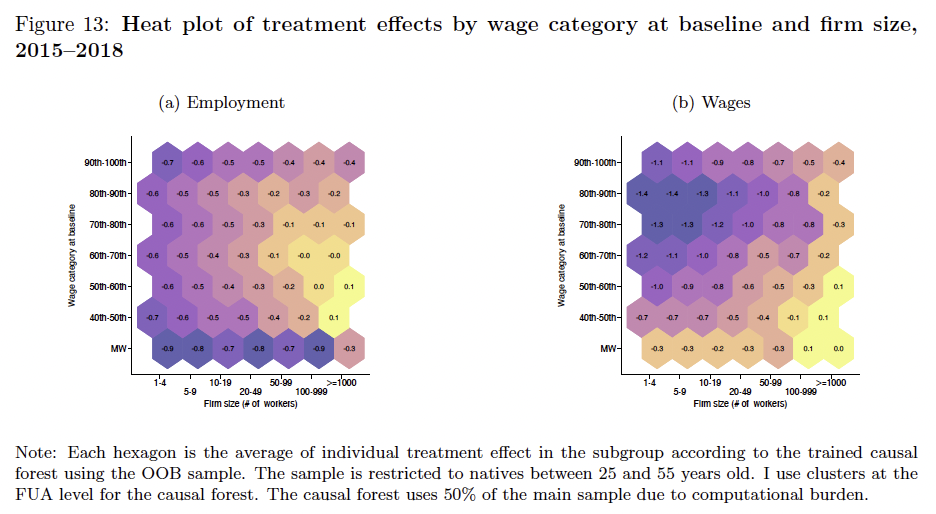The role of firms after migrants arrive is more important than previously thought
By Lukas Delgado-Prieto
Over the last decade, many countries have witnessed significant population outflows, including Afghanistan, Ukraine, Syria, and Venezuela, among others. These migrants often relocate to nearby developing countries where small firms play a crucial role in the labor market. The interplay between the formal and informal sectors is also a key characteristic of these labor markets.
Because migrants often concentrate in small firms as informal workers, it becomes more relevant to study the labor market impacts of immigration exploiting the firm dimension in these contexts. However, papers that explore how firms interact with immigration effects are scarce, partly due to data limitations. If having access to detailed firm information, it would be possible to study if most of the adjustments to immigration do occur in small and less productive firms. But, even with this data, jobs within small firms are not of equal skills, so not all their workers should be equally affected. It is important to study the adjustments to immigration, focusing on all workers across firms.
In my job market paper (Delgado-Prieto, 2023), I address this empirical question by studying the labor market impacts of one of the largest episodes of immigration in recent history, the Venezuelan mass migration to Colombia. I rely on administrative records that cover the universe of formal workers and firms in the country for the analysis.
Institutional context
The historical relationship between Colombia and Venezuela has seen dynamic shifts over time. Notably, there was a substantial influx of Colombians to Venezuela post-1950, largely attributed to the oil boom. However, this trend has recently reversed due to Venezuela’s socio-economic and political crisis since 2013, triggering massive inflows of individuals across several Latin American countries.
In Colombia, the Venezuelan migration has been unique in nature, primarily due to language similarities and welcoming government measures, including work regularization programs initiated since 2018, such as the Special Permit of Permanence (PEP in Spanish) or the Temporary Protection Permit (PPT in Spanish). Despite these policies, approximately 90 percent of Venezuelan immigrants, as of 2019, were employed in the informal sector and were concentrated at the bottom of the native wage distribution. This fact relates to the occupational downgrading of Venezuelans since they have similar average levels of education compared to their Colombian counterparts and are even more educated in the latest years of arrival.
Are immigration effects really concentrated in small firms?
A growing number of studies analyze how firms shape, for instance, wage inequality or immigrant assimilation, but less is known about how firms can determine natives’ adjustments to immigration shocks. Therefore, I exploit the unequal arrival of immigrants across local labor markets to quantify how native formal workers (in different types of firms) react to this shock. My empirical strategy (diff-in-diff) then compares similar workers in areas with different exposure to migration over time.
To deal with the endogenous sorting, I instrument migrant arrivals with past settlements and proximity to border crossings. One typical concern of the instruments is that the Venezuelan crisis can affect border areas more via other shocks, like fewer trade interactions, apart from migrant arrivals. Since the trade shock started some years before the immigration shock, I show several falsification tests before immigrants massively arrived in the country, and the trends between border and non-border areas were not significantly different. Moreover, even when I exclude border areas from the analysis, the main results hold.
In this setup, I find that natives working in small firms present the largest decline in their formal employment. Consistent with the fact that as the majority of Venezuelans cluster in the informal sector, this reduces the wages of informal workers, which in turn decreases the demand for formal workers in small firms as they can swap formal labor for low-priced informal labor more easily (Delgado-Prieto, 2022). This evidence also supports the idea that trade shocks are less of a concern as there are insignificant effects on larger firms that are presumably more affected by trade.
To put more structure on these findings, I construct a partial equilibrium model where firms can hire formal and informal labor and show that the key parameter to explain the negative formal employment effect is the high elasticity of substitution between them. The model also establishes that the impact is more negative in small firms because they hire relatively more informal labor than larger firms.
Besides firm size, the pay premiums of firms (before immigrants arrive) also play a role in explaining immigration effects, as workers in low-paying firms present a negative effect on their earnings. At the same time, native workers in high-paying firms are unaffected. Studying other margins of adjustment, I do not find that formal natives are relocating to other types of firms or to other regions in response to the shock.
Should we focus more on workers or firms?
By type of workers, I find that the reduction in formal employment is driven entirely by natives earning the minimum wage. For these low-wage workers, a one percentage point increase in the share of employed migrants in a given labor market reduces the probability of employment in the formal sector by 1.5 percentage points. The relatively high and binding minimum wage, for around 40 percent of formal workers in Colombia, limits the space for downward wage adjustments and increases their chances of job displacement.
I also find substantial varying effects combining worker and firm characteristics, so I use a machine learning algorithm (causal forests) to analyze heterogeneity more systematically, allowing for non-linear effects and high-order interactions. This method uses variables in the pre-shock period, including age, sex, job tenure, wages, firm pay premiums, worker quality, and firm size, to determine which one explains more the varying employment and wage effects in the post-treatment period. Although worker and firm characteristics are sometimes related (e.g., minimum wage workers often work in smaller firms), according to the algorithm, most heterogeneity comes from the firm side.
For example, the Figure below shows the treatment effects of the causal forests when combining categories of workers’ wages and firm size. Most notably, the employment losses primarily affect minimum wage earners in small and medium-sized firms. Conversely, the most adverse wage effects occur in the upper part of the wage distribution, particularly in small firms, and diminish as firm size increases. Indicating that firms play an influential part in determining the impact of immigration on workers’ outcomes.

Concluding remarks
These findings suggest the need for policies that actively support formal employment. One effective approach could involve easing the burden of labor costs for employers. Simultaneously, stepping up the enforcement of fines for informal worker hiring can act as a deterrent.
Studying a large immigration shock equipped with administrative data in developing countries for workers and firms is unusual. Doing so allows uncovering important sources of heterogeneity that have not been explored previously, as prior findings primarily focused on the effects across worker or industry characteristics. In that sense, my paper highlights that firms are an important aspect in order to understand how native workers and the labor market overall adjust to immigration shocks.
Further Reading:
Amior, M., & Stuhler, J. (2022). Immigration and monopsony: Evidence across the distribution of firms. Working paper.
Arellano-Bover, J., & San, S. (2023). The Role of Firms and Job Mobility in the Assimilation of Immigrants: Former Soviet Union Jews in Israel 1990-2019.
Delgado-Prieto, L. (2022). Immigration, wages, and employment under informal labor markets.
Delgado-Prieto, L. (2023). Immigration and Worker Responses Across Firms: Evidence from Administrative Records in Colombia.
About the author:
Lukas Delgado-Prieto is a Ph.D. candidate at Universidad Carlos III de Madrid broadly interested in labor economics and applied microeconomics.



